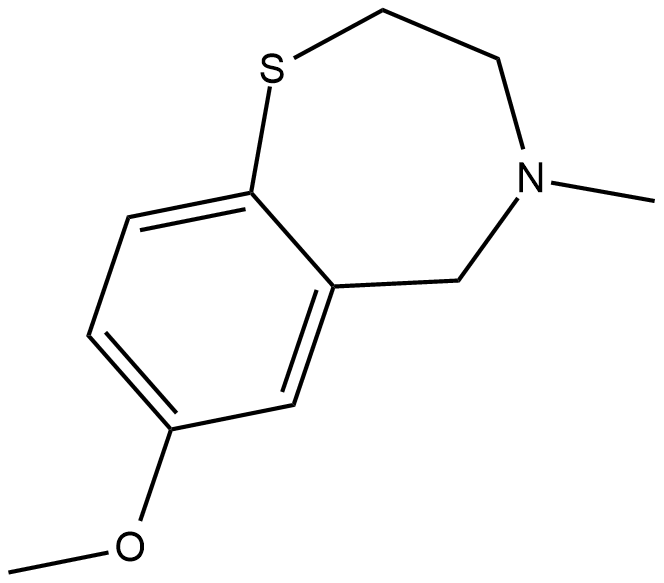S107 |
| Catalog No.GC19393 |
S107 is a RyR-selective 1,4-benzothiazepine derivative that stabilizes RyR2 channels by enhancing the binding affinity of calstabin2 to mutant and/or PKA-phosphorylated channels.
Products are for research use only. Not for human use. We do not sell to patients.

Cas No.: 927871-76-9
Sample solution is provided at 25 µL, 10mM.
S107 is a RyR-selective 1,4-benzothiazepine derivative that stabilizes RyR2 channels by enhancing the binding affinity of calstabin2 to mutant and/or PKA-phosphorylated channels.
S107 is a small compound that enhances calstabin2 binding to RyR2 at low nanomolar concentrations and failed to interact with over 400 receptors, enzymes, and ion channels in screens using up to 10 uM of the compound. S107 has no effect on cardiac ion channels including the voltage-gated Na+, K+, and Ca2+ channels at concentrations up to 10 uM, and S107 had no effect on normal Ca2+ signaling in cells[1]. S107 is a promising candidate drug for treating catecholaminergic polymorphic ventricular tachycardia (CPVT). S107 exerts an antiarrhythmic effect on CPVT-hiPSC-CMs. Pre-incubation with 10 uM S107, which stabilizes the closed state of the ryanodine receptor 2, significantly decreases the percentage of CPVT-hiPSC-CMs presenting DADs to 25%[2]. S107 is thought to improve skeletal muscle function by stabilizing the RyR1-FKBP12 complex. S107 increases FKBP12 binding to RyR1 in SR vesicles in the presence of reduced glutathione and the NO-donor NOC12, with no effect in the presence of oxidized glutathione. S107 can reverse the harmful effects of redox active species on SR Ca2+ release in skeletal muscle by binding to RyR1 low affinity sites[3].
S107, which prevents a leak in the channel but does not block the channel or alter normal Ca2+ signaling, is able to inhibit both seizures and arrhythymias in the mutant mice[1].
References:
[1]. Lehnart SE, et al. Leaky Ca2+ release channel/ryanodine receptor 2 causes seizures and sudden cardiac death in mice. J Clin Invest. 2008 Jun;118(6):2230-45.
[2]. Sasaki K, et al. Patient-Specific Human Induced Pluripotent Stem Cell Model Assessed with Electrical Pacing Validates S107 as a Potential Therapeutic Agent for Catecholaminergic Polymorphic Ventricular Tachycardia. PLoS One. 2016 Oct 20;11(10):e0164795.
[3]. Mei Y, et al. Stabilization of the skeletal muscle ryanodine receptor ion channel-FKBP12 complex by the 1,4-benzothiazepine derivative S107. PLoS One. 2013;8(1):e54208.
Animal experiment: | Mice: To test for protection against seizures using S107, osmotic pumps are implanted, and mice are pretreated with S107 5 mg/kg/h for 1 week prior to seizure susceptibility testing. Phase 4 seizures associated with death could be avoided through intubation and artificial breathing, indicating diaphragm failure during sustained seizures as a potential cause of death. Mice are directly observed and videorecorded for later review and latency classification during a 60-minute observation period[1]. |
References: [1]. Lehnart SE, et al. Leaky Ca2+ release channel/ryanodine receptor 2 causes seizures and sudden cardiac death in mice. J Clin Invest. 2008 Jun;118(6):2230-45. | |
| Cas No. | 927871-76-9 | SDF | |
| Canonical SMILES | COC1=CC=C2C(CN(C)CCS2)=C1 | ||
| Formula | C11H15NOS | M.Wt | 209.31 |
| Solubility | Water : ≥ 132 mg/mL (537.09 mM) | Storage | Store at -20°C |
| General tips | Please select the appropriate solvent to prepare the stock solution according to the
solubility of the product in different solvents; once the solution is prepared, please store it in
separate packages to avoid product failure caused by repeated freezing and thawing.Storage method
and period of the stock solution: When stored at -80°C, please use it within 6 months; when stored
at -20°C, please use it within 1 month. To increase solubility, heat the tube to 37°C and then oscillate in an ultrasonic bath for some time. |
||
| Shipping Condition | Evaluation sample solution: shipped with blue ice. All other sizes available: with RT, or with Blue Ice upon request. | ||
| Prepare stock solution | |||

|
1 mg | 5 mg | 10 mg |
| 1 mM | 4.7776 mL | 23.888 mL | 47.776 mL |
| 5 mM | 0.9555 mL | 4.7776 mL | 9.5552 mL |
| 10 mM | 0.4778 mL | 2.3888 mL | 4.7776 mL |
Step 1: Enter information below (Recommended: An additional animal making an allowance for loss during the experiment)
 g
g
 μL
μL

Step 2: Enter the in vivo formulation (This is only the calculator, not formulation. Please contact us first if there is no in vivo formulation at the solubility Section.)
Calculation results:
Working concentration: mg/ml;
Method for preparing DMSO master liquid: mg drug pre-dissolved in μL DMSO ( Master liquid concentration mg/mL, Please contact us first if the concentration exceeds the DMSO solubility of the batch of drug. )
Method for preparing in vivo formulation: Take μL DMSO master liquid, next addμL PEG300, mix and clarify, next addμL Tween 80, mix and clarify, next add μL ddH2O, mix and clarify.
Method for preparing in vivo formulation: Take μL DMSO master liquid, next add μL Corn oil, mix and clarify.
Note: 1. Please make sure the liquid is clear before adding the next solvent.
2. Be sure to add the solvent(s) in order. You must ensure that the solution obtained, in the previous addition, is a clear solution before proceeding to add the next solvent. Physical methods such as vortex, ultrasound or hot water bath can be used to aid dissolving.
3. All of the above co-solvents are available for purchase on the GlpBio website.
Quality Control & SDS
- View current batch:
- Purity: >98.00%
- COA (Certificate Of Analysis)
- SDS (Safety Data Sheet)
- Datasheet
Average Rating: 5 (Based on Reviews and 40 reference(s) in Google Scholar.)
GLPBIO products are for RESEARCH USE ONLY. Please make sure your review or question is research based.
Required fields are marked with *



















